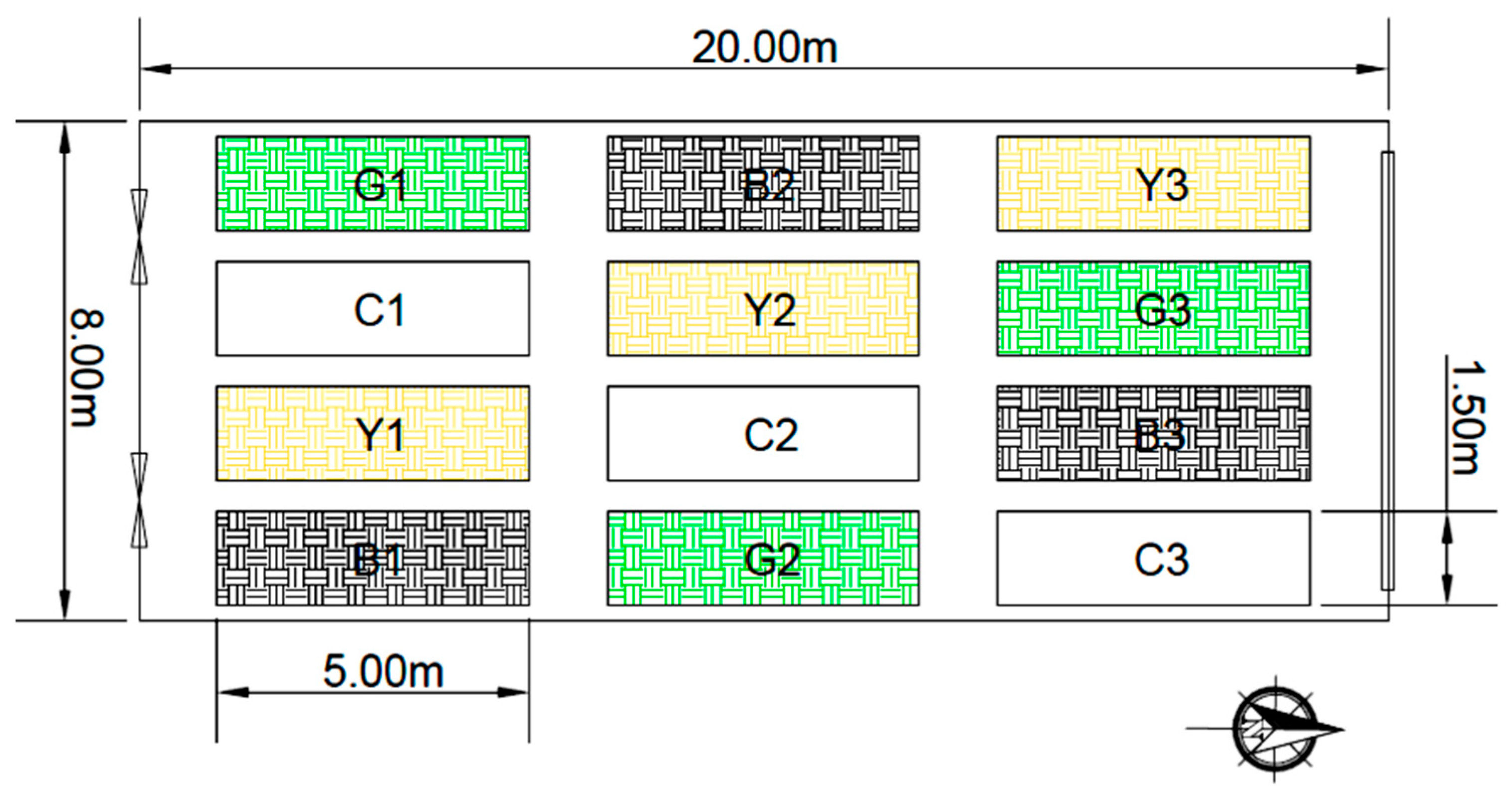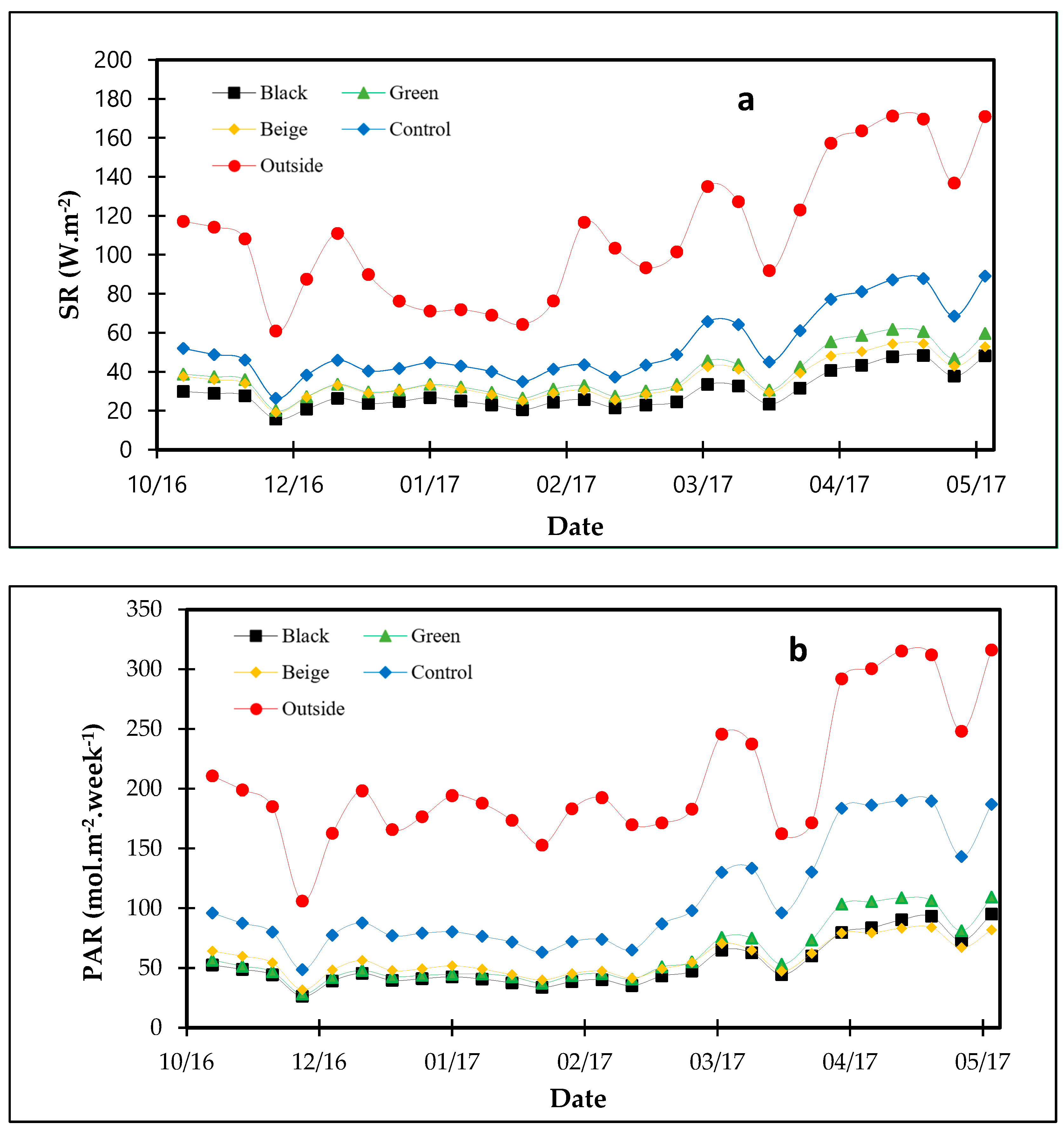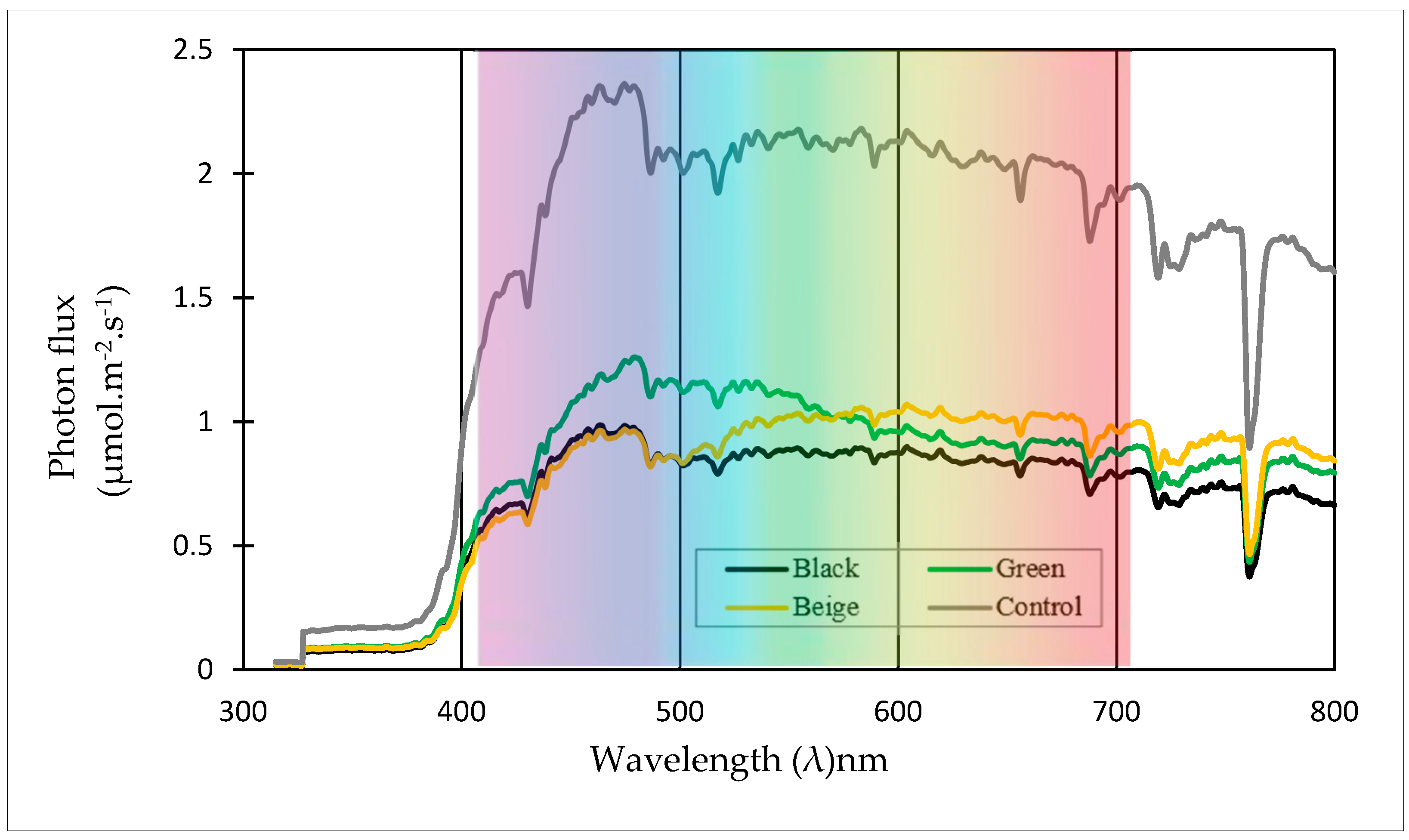Effects of Shading Nets Color on the Internal Environmental Conditions, Light Spectral Distribution, and Strawberry Growth and Yield in Greenhouses
Abstract
1. Introduction
2. Materials and Methods
2.1. The Greenhouse
2.2. Plastic Shading Nets
2.3. Study Layout
2.4. The Crop
2.5. Measurements and Instrumentation
- (i)
- The greenhouse outside and inside air temperature and relative humidity were measured using a combined sensor data logger (OM-EL-USB-2-LCD, Omega Inc., Norwalk, CT, USA). The sensors were programmed to take the experimental measurements every 5 min (Figure 3).
- (ii)
- The global solar radiation flux (SR) and the photosynthetically active radiation (PAR) were measured using the Kipp & Zonen CMP3 Pyranometer and LI-COR LI-190R Quantum Sensors, respectively. The SRg and PAR were measured under each of the shading blocks, unshaded blocks, and outside. The sensors were programmed to scan the experimental measurements every minute, and the average was recorded every five minutes. Data were collected using a LI-COR 1400 data logger (Figure 3).
- (iii)
- The spectral distribution of light was measured every 15 days using the Stellar Net BLACK-Comet Spectrometer at noon throughout the strawberry growth period.
- (iv)
- The photosynthesis rate, transpiration rate, and CO2 concentration were measured using a portable photosynthesis measuring system (LI-6400; Li-COR, Inc., Lincoln, NE, USA) at noon during the mid-stage of strawberry growth.
2.6. Calculation of Radiation Energy
- (i)
- Global solar radiation flux (SR)
- (ii)
- Photosynthetically active radiation (PAR)
- (iii)
- Light spectral distribution calculations
2.7. Growth and Yield Measurements
3. Results
3.1. Microclimate Conditions inside and outside the Greenhouse
3.2. Spectral Distribution of Light
3.3. Physiological Characteristics
3.4. Plant Growth Indices
3.5. Plant Yield
4. Conclusions
Author Contributions
Funding
Data Availability Statement
Acknowledgments
Conflicts of Interest
References
- Oren-Shamir, M.; Gussakovsky, E.; Eugene, E.; Nissim-Levi, A.; Ratner, K.; Ovadia, R.; Giller, Y.; Shahak, Y. Coloured shade nets can improve the yield and quality of green decorative branches of Pittosporum variegatum. J. Hortic. Sci. Biotechnol. 2001, 76, 353–361. [Google Scholar] [CrossRef]
- Robledo de Pedro, F.; Marín, L. Aplicación de los Plásticos en la Agricultura, 2nd ed.; Editorial Mundi-Prensa: Madrid, Spain, 1981; 571p. [Google Scholar]
- Zhang, Q.; Bi, G.; Li, T.; Wang, Q.; Xing, Z.; LeCompte, J.; Harkess, R.L. Color shade nets affect plant growth and seasonal leaf quality of Camellia sinensis grown in Mississippi, the United States. Front. Nutr. 2022, 9, 786421. [Google Scholar] [CrossRef]
- Ilić, S.Z.; Milenković, L.; Dimitrijević, A.; Stanojević, L.; Cvetković, D.; Kevrešan, Ž.; Fallik, E.; Mastilović, J. Light modification by color nets improve quality of lettuce from summer production. Sci. Hortic. 2017, 226, 389–397. [Google Scholar] [CrossRef]
- Díaz-Pérez, J.C.; John, K.S. Bell pepper (Capsicum annum L.) under colored shade nets: Plant growth and physiological responses. HortScience 2019, 54, 1795–1801. [Google Scholar] [CrossRef]
- Shahak, Y.; Lahav, T.; Spiegel, E.; Philosoph-Hadas, S.; Meir, S.; Orenstein, H.; Gussakovsky, E.; Ratner, K.; Giller, Y.; Shapchisky, S. Growing Aralia and Monstera under colored shade nets. Olam Poreah 2002, 13, 60–62. [Google Scholar]
- Shahak, Y.; Gal, E.; Offir, Y.; Ben-Yakir, D. Photoselective shade netting integrated with greenhouse technologies for improved performance of vegetable and ornamental crops. Acta Hortic. 2008, 797, 75–80. [Google Scholar] [CrossRef]
- Stamps, R.H. Use of colored shade netting in horticulture. HortScience 2009, 44, 239–241. [Google Scholar] [CrossRef]
- Stamps, R.; Chandler, A. Differential effects of colored shade nets on three cut foliage crops. Acta Hortic. 2008, 770, 169–176. [Google Scholar] [CrossRef]
- Singh, H.; Dunn, B.L.; Fontanier, C.; Singh, H. Colored Shade Nets Affect Growth but Not Flowering of Four Greenhouse-grown Potted Ornamental Species. HortScience 2023, 58, 1075–1076. [Google Scholar] [CrossRef]
- Torres-Hernández, M.; Rodríguez-Mendoza, M.; Soto-Hernández, M.; Pedraza-Santos, M. Hydroponics and colored shade nets in lisianthus (Eustroma grandiflorum) production. Acta Hortic. 2012, 947, 409–413. [Google Scholar] [CrossRef]
- Nomura, E.S.; Lima, J.D.; Rodrigues, D.S.; Garcia, V.A.; Fuzitani, E.J.; Silva, S.H.M.-G.d. Crescimento e produção de antúrio cultivado sob diferentes malhas de sombreamento. Ciência Rural 2009, 39, 1394–1400. [Google Scholar] [CrossRef]
- Al-Helal, I.M.; Abdel-Ghany, A.M. Measuring and evaluating solar radiative properties of plastic shading nets. Sol. Energy Mater. Sol. Cells 2011, 95, 677–683. [Google Scholar] [CrossRef]
- Castellano, S.; Scarascia Mugnozza, G.; Russo, G.; Briassoulis, D.; Mistriotis, A.; Hemming, S.; Waaijenberg, D. Plastic Nets in Agriculture: A General Review of Types and Applications. Appl. Eng. Agric. 2008, 24, 799–808. [Google Scholar] [CrossRef]
- Heide, O.M. Photoperiod and temperature interactions in growth and flowering of strawberry. Physiol. Plant. 1977, 40, 21–26. [Google Scholar] [CrossRef]
- El-Farhan, A.; Pritts, M. Water requirements and water stress in strawberry. Adv. Strawb. Res. 1997, 16, 5–12. [Google Scholar]
- Klamkowski, K.; Treder, W. Response to drought stress of three strawberry cultivars grown under greenhouse conditions. J. Fruit Ornam. Plant Res. 2008, 16, 179–188. [Google Scholar]
- Watson, R.; Wright, C.; McBurney, T.; Taylor, A.; Linforth, R. Influence of harvest date and light integral on the development of strawberry flavour compounds. J. Exp. Bot. 2002, 53, 2121–2129. [Google Scholar] [CrossRef] [PubMed]
- Ganmore-Neumann, R.; Kafkafi, U. The Effect of Root Temperature and Nitrate/Ammonium Ratio on Strawberry Plants. II. Nitrogen Uptake, Mineral Ions, and Carboxylate Concentrations 1. Agron. J. 1985, 77, 835–840. [Google Scholar] [CrossRef]
- Hideo, I.; Saito, T. Studies on the flower formation in the strawberry plants I. Effects of temperature and photoperiod on the flower formation. Tohoku J. Agric. Res. 1962, 13, 191–203. [Google Scholar]
- Robert, F.; Risser, G.; Pétel, G. Photoperiod and temperature effect on growth of strawberry plant (Fragaria × ananassa Duch.): Development of a morphological test to assess the dormancy induction. Sci. Hortic. 1999, 82, 217–226. [Google Scholar] [CrossRef]
- Watkins, C.; McNicol, R.; Young, K.; Jones, A. The effect of heat treatment and meristem-tip culture on June Yellows in strawberry. Ann. Appl. Biol. 1990, 116, 489–492. [Google Scholar] [CrossRef]
- Wang, S.Y.; Lin, H.-S. Effect of plant growth temperature on membrane lipids in strawberry (Fragaria × ananassa Duch.). Sci. Hortic. 2006, 108, 35–42. [Google Scholar] [CrossRef]
- Al-Helal, I.M.; Abdel-Ghany, A.M. Responses of plastic shading nets to global and diffuse PAR transfer: Optical properties and evaluation. NJAS-Wagening. J. Life Sci. 2010, 57, 125–132. [Google Scholar] [CrossRef]
- Sager, J.C.; McFarlane, J.C. Radiation. In Growth Chamber Handbook; Langhans, R.W., Tibbitts, T.W., Eds.; North Central Regional Research Publication No. 340, Iowa Agriculture and Home Economics Experiment Station Special Report No. 99; Lowa State University: Ames, IA, USA, 1997; pp. 1–29. ISBN 0361-199X. [Google Scholar]
- Abdel-Ghany, A.M.; Kozai, T.; Chun, C. Evaluation of Selected Greenhouse Covers for Use in Regions with a Hot Climate. Jpn. J. Trop. Agr. 2001, 45, 242–250. [Google Scholar]
- Kittas, C.; Baille, A.; Giaglaras, P. Influence of covering material and shading on the spectral distribution of light in greenhouses. J. Agric. Eng. Res. 1999, 73, 341–351. [Google Scholar] [CrossRef]
- Buriol, G.A.; Righi, E.Z.; Schneider, F.M.; Streck, N.A.; Heldwein, A.B.; Estefanel, V. Modificação da umidade relativa do ar pelo uso e manejo da estufa plástica. Rev. Bras. Agrometeorol. 2000, 8, 11–18. [Google Scholar]
- Lugassi-Ben-Hamo, M.; Kitron, M.; Bustan, A.; Zaccai, M. Effect of shade regime on flower development, yield and quality in lisianthus. Sci. Hortic. 2010, 124, 248–253. [Google Scholar] [CrossRef]
- Al-Helal, I.M. Effects of ventilation rate on the environment of a fan-pad evaporatively cooled, shaded greenhouse in extreme arid climates. Appl. Eng. Agric. 2007, 23, 221–230. [Google Scholar] [CrossRef]
- Guiselini, C. Microclima e Produção de Gérbera em Ambientes Protegidos com Diferentes Tipos de Cobertura. Master’s Thesis, Universidade de São Paulo, Piracicaba, Brazil, 2002; 53p. [Google Scholar]
- Shahak, Y.; Gussakovsky, E.E.; Gal, E.; Ganelevin, R. ColorNets: Crop protection and light-quality manipulation in one technology. Acta Hortic. 2004, 659, 143–151. [Google Scholar] [CrossRef]
- Ayala-Tafoya, F.; Zatarain-López, D.; Valenzuela-López, M.; Partida-Ruvalcaba, L.; Velázquez-Alcaraz, T.d.J.; Díaz-Valdés, T.; Osuna-Sánchez, J. Growth and yield of tomato in response to sun radiation transmitted by shade nets. Terra Latinoam. 2011, 29, 403–410. [Google Scholar]
- Tafoya, F.A.; Juárez, M.G.Y.; Orona, C.A.L.; López, R.M.; Alcaraz, T.d.J.V.; Valdés, T.D. Sunlight transmitted by colored shade nets on photosynthesis and yield of cucumber. Ciência Rural. 2018, 48, e20170829. [Google Scholar] [CrossRef]
- Yanagi, T.; Okamoto, K.; Takita, S. Effect of blue and red light intensity on photosynthetic rate of strawberry leaves. Acta Hortic. 1996, 440, 371–376. [Google Scholar] [CrossRef]
- Barzegargolchini, B.; Movafeghi, A.; Dehestani, A.; Mehrabanjoubani, P. Morphological and anatomical changes in stems of Aeluropus littoralis under salt stress. J. Plant Mol. Breed. 2017, 5, 40–48. [Google Scholar]
- Naz, N.; Fatima, S.; Hameed, M.; Ashraf, M.; Naseer, M.; Ahmad, F.; Zahoor, A. Structural and functional aspects of salt tolerance in differently adapted ecotypes of Aeluropus lagopoides from saline desert habitats. Int. J. Agric. Biol. 2018, 20, 41–51. [Google Scholar]
- Murcia, G.; Pontin, M.; Reinoso, H.; Baraldi, R.; Bertazza, G.; Gómez-Talquenca, S.; Bottini, R.; Piccoli, P.N. ABA and GA3 increase carbon allocation in different organs of grapevine plants by inducing accumulation of non-structural carbohydrates in leaves, enhancement of phloem area and expression of sugar transporters. Physiol. Plant. 2016, 156, 323–337. [Google Scholar] [CrossRef]
- Ilić, Z.S.; Fallik, E. Light quality manipulation improves vegetable quality at harvest and postharvest: A review. Environ. Exp. Bot. 2017, 139, 79–90. [Google Scholar] [CrossRef]
- Milenkovic, L.; Ilic, Z.S.; Ðurovka, M.; Kapoulas, N.; Mirecki, N.; Fallik, E. Yield and pepper quality as affected by light intensity using colour shade nets. Poljopr. I Sumar. 2012, 58, 19–23. [Google Scholar]
- Marcelis, L.; Heuvelink, E.; Baan Hofman-Eijer, L.; Den Bakker, J.; Xue, L. Flower and fruit abortion in sweet pepper in relation to source and sink strength. J. Exp. Bot. 2004, 55, 2261–2268. [Google Scholar] [CrossRef]
- Shahak, Y.; Ratner, K.; Giller, Y.E.; Zur, N.; Or, E.; Gussakovsky, E.; Stern, R.; Sarig, P.; Raban, E.; Harcavi, E. Improving solar energy utilization, productivity and fruit quality in orchards and vineyards by photoselective netting. Acta Hortic. 2008, 772, 65–72. [Google Scholar] [CrossRef]







| Period | Temperature (°C) | Relative Humidity (%) | Radiation (SR in kJ·m−2 and PAR in mol·m−2·day−1) | |||||||||
|---|---|---|---|---|---|---|---|---|---|---|---|---|
| Inside | Outside | Inside | Outside | Inside | Outside | |||||||
| Day | Night | Day | Night | Day | Night | Day | Night | SR | PAR | SR | PAR | |
| 1 | 24 | 16 | 21 | 16 | 47 | 82 | 34 | 45 | 4.5 | 7.3 | 11.6 | 25.6 |
| 2 | 27 | 25 | 37 | 30 | 57 | 70 | 16 | 23 | 7.2 | 13.7 | 20.3 | 36.1 |
| Variable | Light Transmission (%) | |||||||
|---|---|---|---|---|---|---|---|---|
| Period 1 | Period 2 | |||||||
| Control | Green | Beige | Black | Control | Green | Beige | Black | |
| SR | 51 | 38 | 37 | 30 | 50 | 35 | 32 | 27 |
| PAR | 43 | 24 | 27 | 22 | 61 | 34 | 30 | 29 |
| Variable | Treatment | |||||||
|---|---|---|---|---|---|---|---|---|
| Period 1 | Period 2 | |||||||
| Control | Green | Beige | Black | Control | Green | Beige | Black | |
| ΔRH (%) | 12 | 13 | 13 | 15 | 31 | 44 | 41 | 46 |
| Δea (kPa) | 0.46 | 0.39 | 0.47 | 0.37 | −2.55 | −2.75 | −2.50 | −2.75 |
| Δes (kPa) | 0.52 | 0.52 | 0.53 | 0.55 | 0.77 | 1.15 | 1.18 | 1.21 |
| Shading Net | PAR (400–700 nm) | Blue Light (400–500 nm) | Green Light (500–600 nm) | Red Light (600–700 nm) | Far-Red Light (700–800 nm) |
|---|---|---|---|---|---|
| Beige | 277.4 a,b * | 77.6 b | 98.3 a | 100.5 a | 87.6 a |
| Green | 295.9 a | 96.9 a | 107.2 a | 90.8 a,b | 79.7 a |
| Black | 250.5 b | 80.1 b | 86.4 b | 83.2 b | 69.7 b |
| Shade Net | BL/RD | RD/FR |
|---|---|---|
| black (B) | 0.963 b * | 1.194 a |
| green (G) | 1.067 a | 1.139 b |
| control (C) | 0.953 b | 1.203 a |
| beige (Y) | 0.771 c | 1.147 b |
| Treatment | Pn | Gtw | Ci | E | TL |
|---|---|---|---|---|---|
| µmol CO2·m−2·s−1 | mol H2O·m−2·s−1 | µmol CO2·mol−1 | µmol H2O·m−2·s−1 | °C | |
| Beige | 11.83 a | 0.19 a | 121 b | 3.23 a | 24.5 a |
| Control | 11.71 a,b | 0.18 a,b | 141 a,b | 2.78 b | 23.7 d |
| Green | 11.69 a,b | 0.17 b | 154 a,b | 2.75 b | 24.2 b |
| Black | 11.58 b | 0.16 b | 161 a | 2.62 b | 23.9 c |
| Treatment | Number of Leaves | Leaf FW (g) | Leaf DW (g) | Leaf Area (cm2) |
|---|---|---|---|---|
| Black | 13.8 b * | 33.22 c | 10.00 c | 314.89 c |
| Green | 17.7 a,b | 42.35 b | 12.53 b | 506.1 b |
| Control | 20.5 a,b | 44.38 b | 12.20 b,c | 474.44 b |
| Beige | 22.3 a,b | 52.55 a | 17.75 a | 711.16 a |
| Treatment | Plant High (cm) | Number of Crowns | Crown Length (cm) | Crowns FW (g) | Crowns DW (g) |
|---|---|---|---|---|---|
| black | 25.7 a | 2.17 c | 2.15 a | 9.23 b | 5.8 a |
| green | 28.2 a | 3.43 b | 2.4 a | 13.53 a | 6.8 a |
| control | 26.2 a | 3.5 b | 2.67 a | 14.25 a | 6.3 a |
| beige | 29 a | 5 a | 2.75 a | 16.6 a | 6.8 a |
| Treatment | Number of Fruit | Fruits FW (g) | Fruits DW (g) | Fruit Length (mm) | Fruit Diameter (mm) |
|---|---|---|---|---|---|
| black | 42.7 a | 15.10 c | 2.14 b | 45.67 a | 35.00 b |
| green | 43.0 a | 16.97 b | 2.41 a | 45.11 a | 34.89 b |
| control | 43.1 a | 18.13 a,b | 2.62 a | 46.11 a | 38.22 a |
| beige | 44.0 a | 18.43 a | 2.63 a | 46.50 a | 38.17 a |
| Treatment | Yield | |
|---|---|---|
| (g per Plant) | (kg·m−2) | |
| black | 642.9 b | 5.14 b |
| green | 729.6 a,b | 5.84 a,b |
| control | 780.3 a | 6.24 a |
| beige | 810.6 a | 6.49 a |
Disclaimer/Publisher’s Note: The statements, opinions and data contained in all publications are solely those of the individual author(s) and contributor(s) and not of MDPI and/or the editor(s). MDPI and/or the editor(s) disclaim responsibility for any injury to people or property resulting from any ideas, methods, instructions or products referred to in the content. |
© 2024 by the authors. Licensee MDPI, Basel, Switzerland. This article is an open access article distributed under the terms and conditions of the Creative Commons Attribution (CC BY) license (https://creativecommons.org/licenses/by/4.0/).
Share and Cite
Alhelal, I.M.; Albadawi, A.A.; Alsadon, A.A.; Alenazi, M.M.; Ibrahim, A.A.; Shady, M.; Al-Dubai, A.A. Effects of Shading Nets Color on the Internal Environmental Conditions, Light Spectral Distribution, and Strawberry Growth and Yield in Greenhouses. Plants 2024, 13, 2318. https://doi.org/10.3390/plants13162318
Alhelal IM, Albadawi AA, Alsadon AA, Alenazi MM, Ibrahim AA, Shady M, Al-Dubai AA. Effects of Shading Nets Color on the Internal Environmental Conditions, Light Spectral Distribution, and Strawberry Growth and Yield in Greenhouses. Plants. 2024; 13(16):2318. https://doi.org/10.3390/plants13162318
Chicago/Turabian StyleAlhelal, Ibrahim M., Ammar A. Albadawi, Abdullah A. Alsadon, Mekhled M. Alenazi, Abdullah A. Ibrahim, Mohamed Shady, and Abdulhakim A. Al-Dubai. 2024. "Effects of Shading Nets Color on the Internal Environmental Conditions, Light Spectral Distribution, and Strawberry Growth and Yield in Greenhouses" Plants 13, no. 16: 2318. https://doi.org/10.3390/plants13162318
APA StyleAlhelal, I. M., Albadawi, A. A., Alsadon, A. A., Alenazi, M. M., Ibrahim, A. A., Shady, M., & Al-Dubai, A. A. (2024). Effects of Shading Nets Color on the Internal Environmental Conditions, Light Spectral Distribution, and Strawberry Growth and Yield in Greenhouses. Plants, 13(16), 2318. https://doi.org/10.3390/plants13162318






